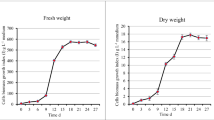Abstract
Transformed root cultures of Datura stramonium, competent in tropane-alkaloid biosynthesis, have been treated with exogenous plant growth regulators. It was found that combinations of α-naphthalene-acetic acid, kinetin (N6-furfurylaminopurine) and 2,4-dichlorophenoxyacetic acid induced de-differentiation, causing both the rooty phenotype and the hyoscyamine-biosynthetic capacity to be lost. Alkaloid biosynthesis disappeared rapidly and prior to the loss of morphological integrity. It was observed that the enzymes ornithine decarboxylase (EC 4.1.1.17), arginine decarboxylase (EC 4.1.1.19) and N-methylputrescine oxidase did not show the increase in level normally associated with subculturing the roots. The level of putrescine N-methyltransferase (EC 2.1.1.53) activity, the first enzyme fully committed to hyoscyamine biosynthesis, rapidly declined, about 80% being lost from the roots within 12h. This activity, although showing some temporary restoration, declined further after a few days, and was totally absent from fully dispersed cultures. N-Methylputrescine oxidase persisted at a low level. Following sub-culture of established de-differentiated lines to plant-growth-regulator-free medium, limited root regeneration occurred. The roots formed showed renewed competence in alkaloid biosynthesis and putrescine N-methyltransferase and N-methylputrescine oxidase activities were restored to their normal levels. The relationship between the morphological state and alkaloid-biosynthetic capacity of the cultures is discussed in relation to the overall control of alkaloid biosynthesis.
Similar content being viewed by others
Abbreviations
- ADC:
-
arginine decarboxylase
- FW:
-
fresh weight
- MPO:
-
N-methylputrescine oxidase
- NAA:
-
α-naphthalineacetic acid
- ODC:
-
ornithine decarboxylase
- pgr:
-
plant growth regulator
- PMT:
-
putrescine N-methyltransferase
References
Aird, E.L.H. (1989) A study on the relationship between organisation, genetic stability and secondary metabolite production of plant cell and organ cultures. Ph.D. thesis, University of East Anglia, Norwich, UK
Aird, E.L.H., Hamill, J.D., Robins, R.J., Rhodes, M.J.C. (1989) Chromosome stability in transformed hairy root cultures and the properties of variant lines of Nicotiana rustica hairy roots. In: Manipulating secondary metabolism in culture, pp. 137–144, Robins, R.J., Rhodes, M.J.C. eds. Cambridge University Press, Cambridge, UK
Flores, H.E. (1987) Use of plant cell and organ culture in the production of biological chemicals. In : Application of biotechnology to agricultural chemistry, pp. 66–86, Lebaron, H., Mumma, R.O., Honeycutt, R.C., Dussing, J.H., eds. American Chemical Soc. Symp. Series
Hamill, J.D., Parr, A.J., Rhodes, M.J.C., Robins, R.J., Walton, N.J. (1987) New routes to plant secondary products. Biotechnology 5, 800–804
Hamill, J.D., Robins, R.J., Parr, A.J., Evans, D.M., Furze, J.M., Rhodes, M.J.C. (1990) Over-expressing a yeast ornithine decarboxylase gene in transgenic roots of Nicotiana rustica leads to enhanced nicotine accumulation. Plant Mol. Biol. 15, 27–38
Hashimoto, T., Yukimune, Y., Yamada, Y. (1986) Tropane alkaloid production in Hyoscyamus root cultures. J. Plant Physiol. 124, 61–75
Hashimoto, T., Yukimune, Y., Yamada, Y. (1989a) Putrescine and putrescine N-methyltransferase in the biosynthesis of tropane alkaloids in cultured roots of Hyoscyamus albus.I. Biochemical studies. Planta 178, 123–130
Hashimoto, T., Yukimune, Y., Yamada, Y. (1989b) Putrescine and putrescine N-methyltransferase in the biosynthesis of tropane alkaloid in cultured roots of Hyoscyamus albus.II. Incorporation of labelled precursors. Planta 178, 131–137
Hilton, M.G., Wilson, P.D.W., Robins, R.J., Rhodes, M.J.C. (1989) Transformed root cultures — fermentation aspects. In: Manipulating secondary metabolism in culture, pp. 239–245, Robins, R.J., Rhodes, M.J.C., eds. Cambridge University Press, Cambridge, UK
Imaseki, H. (1985) Hormonal control of wound-induced responses. In: Encyclopedia of plant physiology, N.S. vol. 11: Hormonal regulation of development III, Role of environmental factors, pp. 485–512, Pharis, R.P., Reid, D.M., eds. Springer-Verlag, Berlin Heidelberg New York
Meyer Y., Aspart, L., Chartier, Y. (1984) Auxin-induced regulation of protein synthesis in tobacco mesophyll protoplasts cultivated in vitro. Plant Physiol. 75, 1027–1033
Parr, A.J., Payne, J., Eagles, J., Chapman, B.T., Robins, R.J., Rhodes, M.J.C. (1990) Variation in tropane alkaloid accumulation within the Solanaceae and strategies for its exploitation. Phytochemistry 29, 2545–2550
Payne, J., Hamill, J.D., Robins, R.J., Rhodes, M.J.C. (1987) Production of hyoscyamine by ‘hairy root’ cultures of Datura stramonium. Planta Med. 53, 474–478
Petersen, R.L. (1973) Control of cambial activity in roots of turnip (Brassica rapa). Can. J. Bot. 51, 475–480
Rhodes, M.J.C., Robins, R.J., Aird, E.L.H., Payne, J., Parr, A.J., Walton, N.J. (1989) Regulation of secondary metabolism in transformed root cultures. In: Primary and secondary metabolism of plant cell cultures II, pp. 58–72, Kurz, W.G.W., ed. Springer-Verlag, Berlin Heidelberg New York
Robins, R.J., Parr, A.J., Payne, J., Walton, N.J., Rhodes, M.J.C. (1990) Factors regulating tropane-alkaloid production in a transformed root culture of a Datura Candida x D. aurea hybrid. Planta 181, 414–422
Robins, R.J., Parr, A.J., Bent, E.G., Rhodes, M.J.C. (1991a) Studies on the biosynthesis of tropane alkaloids in Datura stramonium, 1.The kinetics of alkaloid production and the influence of feeding intermediate metabolites. planta 183, 185–195
Robins, R.J., Parr, A.J., Walton, N.J. (1991b) Studies on the biosynthesis of tropane alkaloids in Datura stramonium.2. On the relative contributions of L-arginine and l-ornithine to the formation of the tropane ring. Planta 183, 196–201
Spencer, A., Hamill, J.D., Rhodes, M.J.C. (1990) Production of terpenes by differentiated shoot cultures of Mentha citrata transformed with Agrobacterium tumefaciens T37. Plant Cell Rep. 8, 601–604
Torrey, J.G. (1953) The effect of certain metabolic inhibitors on vascular tissue differentiation in isolated pea roots. Am. J. Bot. 57, 390–393
Van der Zaal, E.J., Mennes, A.M., Libbenga, K.R. (1987) Auxin-induced rapid changes in translatable mRNAs in tobacco cell suspension cultures. Planta 172, 514–519
Walton, N.J., Robins, R.J., Peerless, A.C.J. (1990) Enzymes of N-methylputrescine biosynthesis in relation to hyoscyamine formation in transformed root cultures of Datura stramonium and Atropa belladonna. Planta 182, 136–141
Author information
Authors and Affiliations
Additional information
We are most grateful to Abigael Peerless and Bridget Chapman for assistance with various part of this work.
Rights and permissions
About this article
Cite this article
Robins, R.J., Bent, E.G. & Rhodes, M.J.C. Studies on the biosynthesis of tropane alkaloids by Datura stramonium L. transformed root cultures. Planta 185, 385–390 (1991). https://doi.org/10.1007/BF00201061
Accepted:
Issue Date:
DOI: https://doi.org/10.1007/BF00201061




